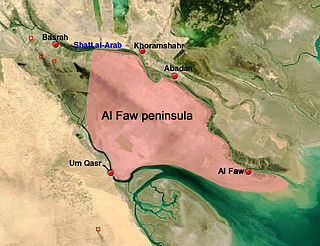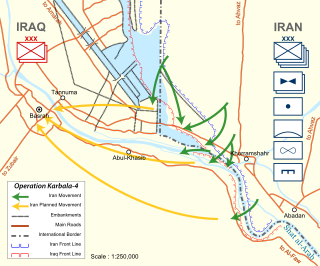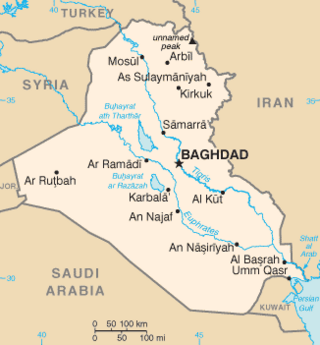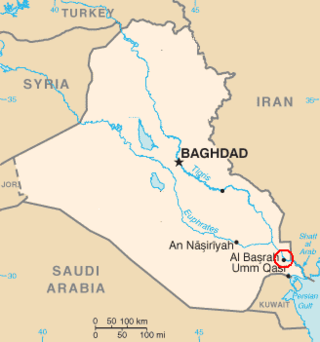
The Iran–Iraq War, also known as the First Gulf War, was an armed conflict between Iran and Iraq that lasted from September 1980 to August 1988. Active hostilities began with the Iraqi invasion of Iran and lasted for nearly eight years, until the acceptance of United Nations Security Council Resolution 598 by both sides. Iraq's primary rationale for the attack against Iran cited the need to prevent Ruhollah Khomeini—who had spearheaded the Iranian revolution in 1979—from exporting the new Iranian ideology to Iraq. There were also fears among the Iraqi leadership of Saddam Hussein that Iran, a theocratic state with a population predominantly composed of Shia Muslims, would exploit sectarian tensions in Iraq by rallying Iraq's Shia majority against the Baʽathist government, which was officially secular but dominated by Sunni Muslims. Iraq also wished to replace Iran as the power player in the Persian Gulf, which was not seen as an achievable objective prior to the Islamic Revolution because of Pahlavi Iran's economic and military superiority as well as its close relationships with the United States and Israel.

The Mahdi Army was an Iraqi Shia militia created by Muqtada al-Sadr in June 2003 and disbanded in 2008.

Amarah, also spelled Amara, is a city in south-eastern Iraq, located on a low ridge next to the Tigris River waterway south of Baghdad about 50 km from the border with Iran. It lies at the northern tip of the marshlands between the Tigris and Euphrates.

The Iraqi Ground Forces, also referred to as the Iraqi Army, is the ground force component of the Iraqi Armed Forces. It was formerly known as the Royal Iraqi Army up until the coup of July 1958. The current commander is Lieutenant General Qassim Muhammad Salih.

The Anglo-Iraqi War was a British-led Allied military campaign during the Second World War against the Kingdom of Iraq, then ruled by Rashid Ali al-Gaylani who had seized power in the 1941 Iraqi coup d'état with assistance from Germany and Italy. The campaign resulted in the downfall of Gaylani's government, the re-occupation of Iraq by the British, and the return to power of the Regent of Iraq, Prince 'Abd al-Ilah, a British ally.

Operation Ramadan was an Iranian offensive in the Iran–Iraq War that consisted of three separate attacks that lasted for 6 weeks. It was launched by Iran on 13 July 1982 near Basra and featured the use of human wave attacks in the largest land battle since World War II. The engagement was a part of the overall stalemate.

The 2004 Iraq spring fighting was a series of operational offensives and various major engagements during the Iraq War. It was a turning point in the war; the spring fighting marked the entrance into the conflict of militias and religiously based militant Iraqi groups, such as the Shi'a Mahdi Army.

The First Battle of al-Faw was a battle of the Iran–Iraq War, fought on the al-Faw peninsula between 10 February and 10 March 1986. The Iranian operation is considered to be one of Iran's greatest achievements in the Iran–Iraq War. The Iranians were able to capture the al-Faw peninsula, cutting off Iraqi access to the Persian Gulf in the process; this in turn hardened Iraqi attitudes to prosecute the war. The Faw peninsula was later recaptured by Iraqi forces near the end of the war.

The Second Battle of al-Faw (also known as the Operation Ramadan Mubarak (Blessed Ramadan), fought on 17 April 1988, was a major battle of the Iran–Iraq War. After their defeat at the First Battle of al-Faw two years earlier, the newly restructured Iraqi Army conducted a major operation to clear the Iranians out of the peninsula.
The Battle of the Marshes was a part of the Iran–Iraq War.
Operation Dawn-1 was an Iranian offensive in the Iran–Iraq War. On April 10, 1983, Iran struck Ayn Al-Qaws with the immediate objective of Al-Fakkah Field to capture the Baghdad-Basra Highway. The operation was fought mostly by Pasdaran forces and was one of the three costly human wave offensives of 1983, the Iranians failed to defeat the Iraqis.
![<span class="mw-page-title-main">Operation Badr (1985)</span> 1985 military operation during the [[Iran-Iraq war]]](https://upload.wikimedia.org/wikipedia/commons/thumb/b/b6/Operation_Badr%2C_Map.jpg/320px-Operation_Badr%2C_Map.jpg)
Operation Badr was an Iranian operation conducted during the Iran–Iraq War against the forces of Ba'athist Iraq. The Iranians launched their offensive on March 10 and succeeded in capturing a part of the Basra-Amarah-Baghdad highway. The following Iraqi counterattack, however, forced the Iranians out in a continual war of endless stalemate.

Operation Karbala-4 was an Iranian offensive in the Iran–Iraq War on the southern front. The operation was launched after the failure of Operation Karbala-2 and Operation Karbala-3 to move the Iraqi lines in an effort to capture Iraqi territory.

Operation Zafar 7 was an Iranian offensive during the Iran–Iraq War. The Iranian military operation was successfully led by Lieutenant General Hossein Hassani Sa'di where Iran won the battle and also repelled the ensuing Iraqi Counterattack. However, Iran faced technical setbacks with massive economic and military sanctions in place against the country. As a result of those setbacks, Iran was unable to reach its objective of capturing Sulaymaniyah.
Operation Dawn 6 was a military operation conducted by the forces of the Islamic Republic of Iran against the armed forces of Saddam Hussein's Iraq. It lasted from 22 to 24 February 1984 and, along with Operation Dawn 5, it was part of a larger strategic operation to secure part of the Baghdad–Basra highway, thus cutting two of Iraq's most important cities from each other, and threatening the network supplying the Iraqi military on the front line. Operation Before the Dawn succeeded in capturing some high ground 15 miles from the highway, and Operation Dawn 6 was designed to exploit the Iranians' capture with a breakthrough towards the highway. However, the operation met an Iraqi defence which stood up to every attack, and the Iranians called off the attack after only two days. This led to Operation Kheibar, the re-focus of the Iranian offensive towards Basra directly.

The Battle of Basra began on 25 March 2008, when the Iraqi Army launched an operation to drive the Mahdi Army militia out of the southern Iraqi city of Basra. The operation was the first major operation to be planned and carried out by the Iraqi Army since the invasion of 2003.

The 2008 Iraq spring fighting was a series of clashes between the Mahdi Army and allies and the Iraqi Army supported by coalition forces, in southern Iraq and parts of Baghdad, that began with an Iraqi offensive in Basra.

The Battle of Al Faw began on 20 March 2003 and continued for four days, as part of the 2003 invasion of Iraq.

The Battle of Samawah took place during the 2003 invasion of Iraq as American troops fought to clear the city of Iraqi forces. The city had been bypassed during the advance on Baghdad, leaving the task of clearing it to American paratroopers of the 82nd Airborne Division with mechanized infantry and armor provided by units of the 1st Battalion, 41st Infantry Regiment, and 2-70th Armor Battalions, along with 3rd platoon 59th Chemical Company tasked with finding and removing any potential chemical or biological weapons. The battle was the largest sustained urban combat that paratroopers of the 82nd Airborne had been involved in since World War II.

Operation Tawakalna ala Allah were a series of five highly successful Iraqi offensives launched in April 1988 and lasting until July 1988. Iraq had originally only intended to retake the al-Faw peninsula it had lost to Iran, but following the battles' extraordinary success due to the complete collapse of the Iranian troops present, the Iraqi command decided to expand the battle into a larger offensive campaign, ultimately leading to the expulsion of all Iranian forces present within Iraq and subsequent renewed invasion of Iran.









![<span class="mw-page-title-main">Operation Badr (1985)</span> 1985 military operation during the [[Iran-Iraq war]]](https://upload.wikimedia.org/wikipedia/commons/thumb/b/b6/Operation_Badr%2C_Map.jpg/320px-Operation_Badr%2C_Map.jpg)





